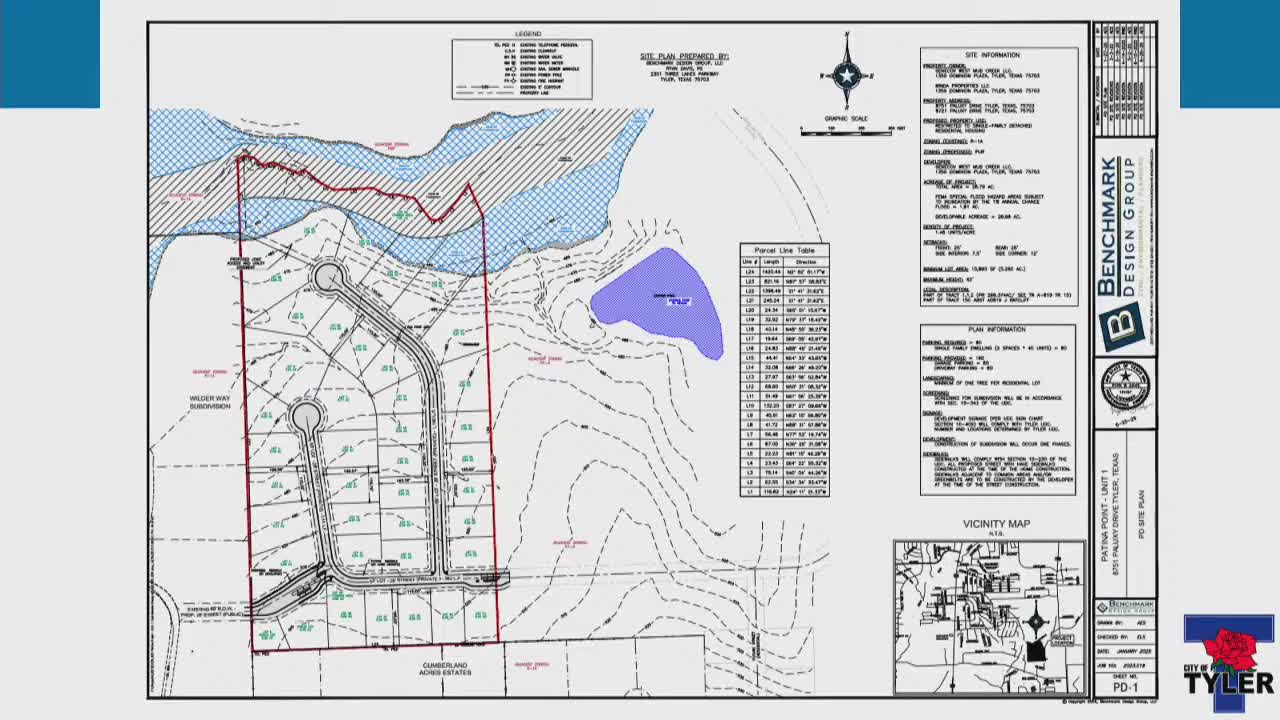Tyler City Council reviews Geneco Group's proposed lower density residential development
July 02, 2025 | Tyler, Smith County, Texas
This article was created by AI summarizing key points discussed. AI makes mistakes, so for full details and context, please refer to the video of the full meeting. Please report any errors so we can fix them. Report an error »

In the heart of Tyler, Texas, the City Planning and Zoning Meeting on July 1, 2025, brought together residents and city officials to discuss a proposed residential development that has stirred both interest and concern among the community. As the sun dipped below the horizon, casting a warm glow over the city hall, the atmosphere was charged with anticipation and apprehension.
The proposed development, set to be built on a portion of the former Mansell farm, aims to create a gated residential neighborhood with a density of less than 1.5 units per acre. This is notably lower than the current zoning allowance of 4 to 5 units per acre. City staff recommended approval, citing that the project aligns with existing regulations regarding setbacks, density, and landscaping. However, the plan has not been without its detractors.
During the meeting, several residents voiced their concerns about the potential impact on traffic and water runoff in the area. Jim Clark, a local resident, highlighted the existing congestion on Cumberland Road, expressing fears that the new development would exacerbate the situation. He presented a video showing water pooling on the road, emphasizing the need for a thorough study on drainage issues before proceeding. “With this additional development, it’s just going to be worse,” he warned.
John Sauls, another resident, echoed these sentiments, stressing the importance of maintaining green space to mitigate runoff. “The more people you have in a certain area, the less green space there’s going to be,” he cautioned, urging the council to consider the environmental implications of reducing lot sizes.
In response, Trey Brewer, vice president of the Geneco Group, assured the council that they are committed to addressing these concerns. He noted that a traffic study had already been conducted, indicating that the existing roads could handle the additional traffic. Brewer emphasized their intention to develop a high-end neighborhood that aligns with the community's desires for larger lots and lower density.
Despite the developer's reassurances, the meeting revealed a palpable tension between the aspirations for growth and the residents' desire for preservation. As discussions unfolded, it became clear that the future of this development would not only shape the landscape of Tyler but also test the balance between progress and community well-being.
As the meeting concluded, the council faced the challenging task of weighing the benefits of new housing against the valid concerns raised by residents. The outcome of this proposal will likely set a precedent for future developments in Tyler, making it a pivotal moment for the city and its residents.
The proposed development, set to be built on a portion of the former Mansell farm, aims to create a gated residential neighborhood with a density of less than 1.5 units per acre. This is notably lower than the current zoning allowance of 4 to 5 units per acre. City staff recommended approval, citing that the project aligns with existing regulations regarding setbacks, density, and landscaping. However, the plan has not been without its detractors.
During the meeting, several residents voiced their concerns about the potential impact on traffic and water runoff in the area. Jim Clark, a local resident, highlighted the existing congestion on Cumberland Road, expressing fears that the new development would exacerbate the situation. He presented a video showing water pooling on the road, emphasizing the need for a thorough study on drainage issues before proceeding. “With this additional development, it’s just going to be worse,” he warned.
John Sauls, another resident, echoed these sentiments, stressing the importance of maintaining green space to mitigate runoff. “The more people you have in a certain area, the less green space there’s going to be,” he cautioned, urging the council to consider the environmental implications of reducing lot sizes.
In response, Trey Brewer, vice president of the Geneco Group, assured the council that they are committed to addressing these concerns. He noted that a traffic study had already been conducted, indicating that the existing roads could handle the additional traffic. Brewer emphasized their intention to develop a high-end neighborhood that aligns with the community's desires for larger lots and lower density.
Despite the developer's reassurances, the meeting revealed a palpable tension between the aspirations for growth and the residents' desire for preservation. As discussions unfolded, it became clear that the future of this development would not only shape the landscape of Tyler but also test the balance between progress and community well-being.
As the meeting concluded, the council faced the challenging task of weighing the benefits of new housing against the valid concerns raised by residents. The outcome of this proposal will likely set a precedent for future developments in Tyler, making it a pivotal moment for the city and its residents.
View full meeting
This article is based on a recent meeting—watch the full video and explore the complete transcript for deeper insights into the discussion.
View full meeting
